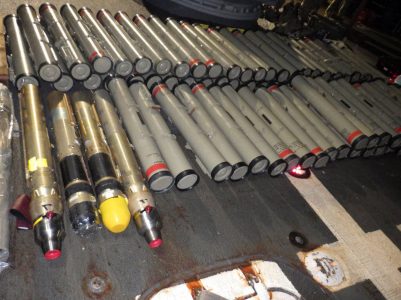
American officials call out Iranian-backed weapons smugglers
Recognizing Iranian-backed weapons smugglers have the advantage evading U.S. patrols, and the Pentagon is taking to publicly calling out Tehran for helping fuel the ongoing conflict in Yemen.
Iran has funneled weapons to Houthi rebels fighting in Yemen for five years. The U.S. Navy has interdicted six shipments, but U.S. Central Command officials suspect more have reached their destinations.
In just the past four months, two U.S. Navy ships have stopped two shipments containing a variety of advanced weapons, many of which are Iranian-made versions of Russian designs or Iranian-designed munitions, said Navy Capt. Bill Urban, the spokesman for Central Command, during a media briefing Wednesday.
“The Houthis have used these Iranian-designed systems to conduct lethal attacks against civil, commercial and military targets on the Arabian Peninsula,” Urban said.
On Feb. 9, a cache of Iranian-made anti-tank missiles and other munitions were seized from an unflagged dhow by the USS Normandy (CG-60), which was conducting maritime security operations in the Arabian Sea.
The seized weapons include:
-150 Dehlavieh anti-tank missiles, which are Iranian-made version of the Russian Kornet anti-tank missiles
-Three Iranian-made surface-to-air missiles
-Thermal imaging weapon scopes
-Components for manned and unmanned aerial and surface vessels
In November, Arleigh Burke-class guided-missile destroyer USS Forrest Sherman (DDG-98) stopped a dhow loaded with a similar cache of weapons, Urban said.
The dhow operators were interrogated by U.S. Navy personnel and their electronic equipment analyzed, which gives Pentagon officials a good idea of the weapons origin and destination, Urban said. The dhow operators were turned over to the Yemeni Coast Guard.
“If the weapons were manufactured in Iran, then they came from Iran, and certainly 150 anti-tank guided missiles do not just walk away, they are illicitly smuggled for a purpose and that purpose is the spread of lethal assistance to the Houthis, Iranian proxies,” Urban said. “There’s not a plausible explanation for how these weapons got on the dhow without the sanction of the Iranian government. ”
The seizures are consistent with a historical pattern of Iranian smuggling of advanced weapons to the Houthis in Yemen, Urban said. The weapons seized carry tell-tale markings signifying their manufacture in Iran. The components seized are also similar to equipment found on the battlefield or after attacks.
“This includes components of the 351 land-attack cruise missile and that’s the missile used by Iran to attack the ARAMCO refineries in the Kingdom of Saudi Arabia last September,” Urban said. “We’re doing everything we can to expose the malign activities that we observe.”
Source: USNI News





